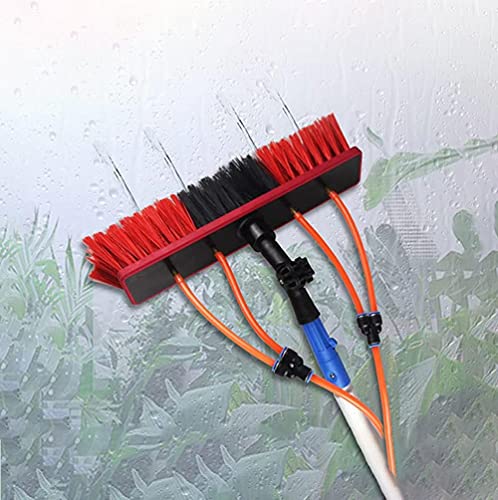- Messages
- 9,500
- Location
- Teesside
Split Charge Relay.
Most window cleaners who use the Water Fed Pole with a van mounted tank will, sooner or later, question whether they need to add an auxiliary charging method for their leisure battery that’s driven from the vehicle’s alternator or not.
A Split Charge Relay (SCR) is now a standard towing accessory in the caravanning and motorhome (RV) leisure industries, so we as window cleaners have a well trodden path to follow. But what is a SCR and how does it work?
Some manufacturers call these relays separators, which is perhaps a better description as they keep the vehicle’s starter battery and the leisure battery separate or isolated and only link them together when the vehicle’s engine is running. So their purpose is to preserve the charge in the starter battery whilst current or power is being drawn from the leisure battery. This means that if all the power from the leisure battery is drawn (it’s now flat) there will still be a full charge in the starter battery to start the vehicle’s engine.
The original SCR’s were basically standard relays. Over time a Voltage Sensing Relay (VSR) or an Intelligent Split Charge Relay has become the most popular to fit. It is a little simpler to fit and it is activated via voltage sensing electronics inside the relay.
Some window cleaners advise that once they have fitted an SCR or VSR they haven’t needed to supplementary charge their leisure battery since. Others aren’t as fortunate and do need to top the charge of their leisure batteries up periodically. The frequency of supplementary charging would very much depend on much power is being drawn by the system and how much mileage is driven a day.
A justifiable assumption is that most Shurflo or equivalent water pumps will draw about 4.5 amps each hour they are running if being controlled by a mainstream controller. Obviously a window cleaner working 8 hours a day won’t be running his pump for 8 hours. Actual pump running time will vary from one window cleaner to another and is very dependent on the makeup of his round. It will also differ from day to day. Current draw will increase with a second operator and with any additional accessories such as a diesel heater or electric hose reel.
A window cleaner will be able to estimate how many amps he has drawn from is battery by estimating how many hours a day the pump/pumps has/have worked. In our experience we have settled on about 50% of time on residential cleans and in the region of 80% on commercial cleans with a large number of windows. So in theory this means that if I run my pump for 2 hours and use 9 amps (4.5amps x 2) then it will take about an hour of charging the battery to replace that charge at 10 amps.
But in reality, it takes longer. The reason is that the fuller the charge in the leisure battery the less charge the leisure battery will take. It has been likened to a sponge; the more saturated it is with water the less it will absorb. I once read in a split charge relay guide that it would take a journey of 750km to fully recharge a flat leisure battery in an RV.
Numax, who are manufacturers and suppliers of quality leisure batteries, advise that a leisure battery shouldn’t be charged at a rate higher than 10% of the battery’s capacity. So a 110amph leisure battery shouldn’t be charged above 11 amps.
Drawing 9 amps from a fully charged 110amp leisure battery will mean that the battery has 101 amps remaining (110 – 9 = 101.)
Letting a starter battery go flat will damage it whereas a leisure battery will tolerate going flat more often. So one of the descriptive terms of a leisure battery is a Deep Cycle Battery and the specs will usually advise how many deep cycles the battery should handle. However, a leisure battery will give better service if the battery is fully recharged as soon as possible. It is also recommended to never let a leisure battery drop below a 50% charge. This is worth noting as more and more leisure battery manufacturers refuse to give warranty on leisure battery used by window cleaners as we abuse them due to the nature of our demands on them.
Modern vehicles all use alternators to charge the battery. Even if the alternator has to supply current to other accessories, ie lights, the alternator will still charge the leisure battery at the same rate. It makes no difference if you are driving down the motorway or stood idling at the traffic lights. So whilst getting stuck in a traffic jam is very frustrating, it’s good for your leisure battery.
Battery to Battery chargers.
Vehicles manufacturers are being forced by emission regulations to become more environmentally friendly. This has meant that there is a real possibility that vans registered after 2015 are likely to have smart alternators, stop start and regenerative charging.
A conventional Voltage Sensing Relay will not work on these vans, especially if they have regenerative charging. Regenerative charging is simply a system that recharges the battery when a vehicle is decelerating. The van’s ECU will instruct the alternator to charge the van’s starter battery until it is 80% full. It then leaves the remaining 20% to be charged when the vehicle is decelerating on a downhill, braking or slowing down for traffic lights etc. The alternator then puts a high voltage current into the battery. To accommodate this, the battery is now a calcium battery as a lead acid battery won’t tolerate the high voltages. Alternators are bigger and battery capacity has also increased; in some cases both by as much as 100% or more.
Sterling Power Products have been in the forefront of auxiliary battery charging for many years. Their pedigree is from the ambulance service and the Marine industry. According to Sterling their Battery to Battery charger does NOT take current from the starter battery for charging the leisure battery. Rather is uses alternator power to charge the leisure battery. (A ‘smart’ alternator still puts out a nominal voltage of 12.4v so it’s ready to dump a large charge into the starter batter at a moment’s notice. But 12.4v isn’t sufficient to charge the battery. So the Sterling Battery to Battery charger uses that 12.4 volts from the alternator and boosts it up to 14.4 volts which then charges the leisure battery.) There is a wiring schematic included in the pack to accommodate different charging modes. When the regenerative program activates, the battery to battery charger also regulates the voltage of the alternators output so it doesn’t damage the leisure battery. (Under regenerative charging the voltage can reach 15.5v on Ford vehicles and as high as 17.0v + on Renaults according to Sterling. Charging a lead acid battery at these voltages will cause gassing and premature lead acid leisure battery failure.)
A battery to battery charger is much more expensive than the old VSR but as demand increases then they should become cheaper to buy as ‘mass’ production reduces manufacturing costs as does manufacturer competition.
Currently the Sterling BB1230 seems a pretty good buy.
https://sterling-power.com/collections/battery-to-battery-chargers/products/2015-battery-to-battery-chargers-non-waterproof-drip-proof-ip21
At the time of writing (May 2017) they are available via an Ebay supplier for £200.00 with free postage.
These B2B chargers can also be used as replacement for the VSR on older systems and, according to Sterling, will do a better job at charging the leisure battery. Conventional alternators are brilliant at supplying all the power a vehicle’s owner needs, eg., lights, windscreen wipers, radio etc. But they aren’t good battery chargers.
.
Most window cleaners who use the Water Fed Pole with a van mounted tank will, sooner or later, question whether they need to add an auxiliary charging method for their leisure battery that’s driven from the vehicle’s alternator or not.
A Split Charge Relay (SCR) is now a standard towing accessory in the caravanning and motorhome (RV) leisure industries, so we as window cleaners have a well trodden path to follow. But what is a SCR and how does it work?
Some manufacturers call these relays separators, which is perhaps a better description as they keep the vehicle’s starter battery and the leisure battery separate or isolated and only link them together when the vehicle’s engine is running. So their purpose is to preserve the charge in the starter battery whilst current or power is being drawn from the leisure battery. This means that if all the power from the leisure battery is drawn (it’s now flat) there will still be a full charge in the starter battery to start the vehicle’s engine.
The original SCR’s were basically standard relays. Over time a Voltage Sensing Relay (VSR) or an Intelligent Split Charge Relay has become the most popular to fit. It is a little simpler to fit and it is activated via voltage sensing electronics inside the relay.
Some window cleaners advise that once they have fitted an SCR or VSR they haven’t needed to supplementary charge their leisure battery since. Others aren’t as fortunate and do need to top the charge of their leisure batteries up periodically. The frequency of supplementary charging would very much depend on much power is being drawn by the system and how much mileage is driven a day.
A justifiable assumption is that most Shurflo or equivalent water pumps will draw about 4.5 amps each hour they are running if being controlled by a mainstream controller. Obviously a window cleaner working 8 hours a day won’t be running his pump for 8 hours. Actual pump running time will vary from one window cleaner to another and is very dependent on the makeup of his round. It will also differ from day to day. Current draw will increase with a second operator and with any additional accessories such as a diesel heater or electric hose reel.
A window cleaner will be able to estimate how many amps he has drawn from is battery by estimating how many hours a day the pump/pumps has/have worked. In our experience we have settled on about 50% of time on residential cleans and in the region of 80% on commercial cleans with a large number of windows. So in theory this means that if I run my pump for 2 hours and use 9 amps (4.5amps x 2) then it will take about an hour of charging the battery to replace that charge at 10 amps.
But in reality, it takes longer. The reason is that the fuller the charge in the leisure battery the less charge the leisure battery will take. It has been likened to a sponge; the more saturated it is with water the less it will absorb. I once read in a split charge relay guide that it would take a journey of 750km to fully recharge a flat leisure battery in an RV.
Numax, who are manufacturers and suppliers of quality leisure batteries, advise that a leisure battery shouldn’t be charged at a rate higher than 10% of the battery’s capacity. So a 110amph leisure battery shouldn’t be charged above 11 amps.
Drawing 9 amps from a fully charged 110amp leisure battery will mean that the battery has 101 amps remaining (110 – 9 = 101.)
Letting a starter battery go flat will damage it whereas a leisure battery will tolerate going flat more often. So one of the descriptive terms of a leisure battery is a Deep Cycle Battery and the specs will usually advise how many deep cycles the battery should handle. However, a leisure battery will give better service if the battery is fully recharged as soon as possible. It is also recommended to never let a leisure battery drop below a 50% charge. This is worth noting as more and more leisure battery manufacturers refuse to give warranty on leisure battery used by window cleaners as we abuse them due to the nature of our demands on them.
Modern vehicles all use alternators to charge the battery. Even if the alternator has to supply current to other accessories, ie lights, the alternator will still charge the leisure battery at the same rate. It makes no difference if you are driving down the motorway or stood idling at the traffic lights. So whilst getting stuck in a traffic jam is very frustrating, it’s good for your leisure battery.
Battery to Battery chargers.
Vehicles manufacturers are being forced by emission regulations to become more environmentally friendly. This has meant that there is a real possibility that vans registered after 2015 are likely to have smart alternators, stop start and regenerative charging.
A conventional Voltage Sensing Relay will not work on these vans, especially if they have regenerative charging. Regenerative charging is simply a system that recharges the battery when a vehicle is decelerating. The van’s ECU will instruct the alternator to charge the van’s starter battery until it is 80% full. It then leaves the remaining 20% to be charged when the vehicle is decelerating on a downhill, braking or slowing down for traffic lights etc. The alternator then puts a high voltage current into the battery. To accommodate this, the battery is now a calcium battery as a lead acid battery won’t tolerate the high voltages. Alternators are bigger and battery capacity has also increased; in some cases both by as much as 100% or more.
Sterling Power Products have been in the forefront of auxiliary battery charging for many years. Their pedigree is from the ambulance service and the Marine industry. According to Sterling their Battery to Battery charger does NOT take current from the starter battery for charging the leisure battery. Rather is uses alternator power to charge the leisure battery. (A ‘smart’ alternator still puts out a nominal voltage of 12.4v so it’s ready to dump a large charge into the starter batter at a moment’s notice. But 12.4v isn’t sufficient to charge the battery. So the Sterling Battery to Battery charger uses that 12.4 volts from the alternator and boosts it up to 14.4 volts which then charges the leisure battery.) There is a wiring schematic included in the pack to accommodate different charging modes. When the regenerative program activates, the battery to battery charger also regulates the voltage of the alternators output so it doesn’t damage the leisure battery. (Under regenerative charging the voltage can reach 15.5v on Ford vehicles and as high as 17.0v + on Renaults according to Sterling. Charging a lead acid battery at these voltages will cause gassing and premature lead acid leisure battery failure.)
A battery to battery charger is much more expensive than the old VSR but as demand increases then they should become cheaper to buy as ‘mass’ production reduces manufacturing costs as does manufacturer competition.
Currently the Sterling BB1230 seems a pretty good buy.
https://sterling-power.com/collections/battery-to-battery-chargers/products/2015-battery-to-battery-chargers-non-waterproof-drip-proof-ip21
At the time of writing (May 2017) they are available via an Ebay supplier for £200.00 with free postage.
These B2B chargers can also be used as replacement for the VSR on older systems and, according to Sterling, will do a better job at charging the leisure battery. Conventional alternators are brilliant at supplying all the power a vehicle’s owner needs, eg., lights, windscreen wipers, radio etc. But they aren’t good battery chargers.
.
Last edited by a moderator:






























